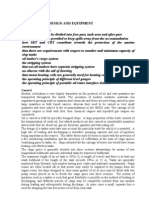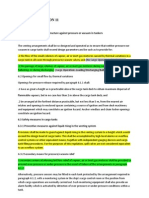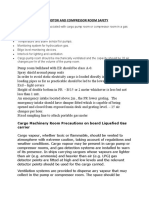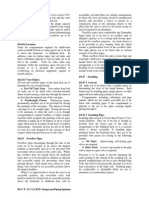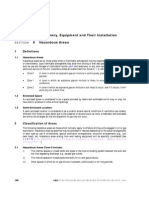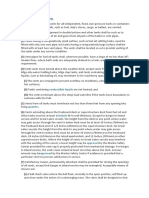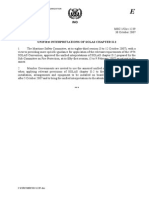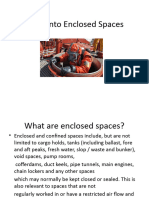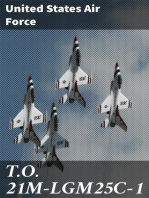Ship Arrangements: 3.1 Segregation of The Cargo Area
Ship Arrangements: 3.1 Segregation of The Cargo Area
Uploaded by
Putra AdamCopyright:
Available Formats
Ship Arrangements: 3.1 Segregation of The Cargo Area
Ship Arrangements: 3.1 Segregation of The Cargo Area
Uploaded by
Putra AdamOriginal Title
Copyright
Available Formats
Share this document
Did you find this document useful?
Is this content inappropriate?
Copyright:
Available Formats
Ship Arrangements: 3.1 Segregation of The Cargo Area
Ship Arrangements: 3.1 Segregation of The Cargo Area
Uploaded by
Putra AdamCopyright:
Available Formats
IMO IGC Code Chapter 3 - Ship arrangements
Chapter 3 Ship arrangements
3.1
3.1.1
Segregation of the cargo area
Hold spaces should be segregated from machinery and boiler spaces, accommodation spaces, service spaces and control stations, chain lockers, drinking and domestic water tanks and from stores. Hold spaces should be located forward of machinery spaces of category A, other than those deemed necessary by the Administration for the safety or navigation of the ship. Where cargo is carried in a cargo containment system not requiring a secondary barrier, segregation of hold spaces from spaces referred to in 3.1.1 or spaces either below or outboard of the hold spaces may be effected by cofferdams, fuel oil tanks or a single gastight bulkhead of all-welded construction forming an A-60 class division. A gastight A-0 class division is satisfactory if there is no source of ignition or fire hazard in the adjoining spaces.
3.1.2
3.1.3 Where cargo is carried in a cargo containment system requiring a secondary barrier, segregation of hold spaces from spaces referred to in 3.1.1 or spaces either below or outboard of the hold spaces which contain a source of ignition or fire hazard should be effected by cofferdams or fuel oil tanks. If there is no source of ignition or fire hazard in the adjoining space, segregation may be by a single A-0 class division which is gastight. 3.1.4
When cargo is carried in a cargo containment system requiring a secondary barrier : .1 at temperatures below 10 C, hold spaces should be segregated from the sea by a double bottom ; and at temperatures below 55 C, the ship should also have a longitudinal bulkhead forming side tanks.
.2
3.1.5
Any piping system which may contain cargo or cargo vapour should : .1 be segregated from other piping systems, except where interconnections are required for cargo-related operations such as purging, gas-freeing or inerting. In such cases, precautions should be taken to ensure that cargo or cargo vapour cannot enter such other piping systems through the interconnections ; except as provided in chapter 16, not pass through any accommodation space, service space or control station or through a machinery space other than a cargo pump-room or cargo compressor space ; be connected into the cargo containment system directly from the open deck except that pipes installed in a vertical trunkway or equivalent may be used to traverse void spaces
.2
.3
23
IMO IGC Code Chapter 3 - Ship arrangements
above a cargo containment system and except that pipes for drainage, venting or purging may traverse cofferdams ; .4 except for bow or stern loading and unloading arrangements in accordance with 3.8 and emergency cargo jettisoning piping systems in accordance with 3.1.6, and except in accordance with chapter 16, be located in the cargo area above the open deck ; and except for thwartship shore connection piping not subject to internal pressure at sea or emergency cargo jettisoning piping systems, be located inboard of the transverse tank location requirements of 2.6.1.
.5
3.1.6
Any emergency cargo jettisoning piping system should comply with 3.1.5 as appropriate and may be led aft externally to accommodation spaces, service spaces or control stations or machinery spaces, but should not pass through them. If an emergency cargo jettisoning piping system is permanently installed, a suitable means of isolation from the cargo piping should be provided within the cargo area. Arrangements should be made for sealing the weather decks in way of openings for cargo containment systems.
3.1.7
3.2
3.2.1
Accommodation, service and machinery spaces and control stations
No accommodation space, service space or control station should be located within the cargo area. The bulkhead of accommodation spaces, service spaces or control stations which face the cargo area should be so located as to avoid the entry of gas from the hold space to such spaces through a single failure of a deck or bulkhead on a ship having a containment system requiring a secondary barrier.
3.2.2
In order to guard against the danger of hazardous vapours, due consideration should be given to the location of air intakes and openings into accommodation, service and machinery spaces and control stations in relation to cargo piping, cargo vent systems and machinery space exhausts from gas burning arrangements. Access through doors, gastight or otherwise, should not be permitted from a gas-safe space to a gas-dangerous space, except for access to service spaces forward of the cargo area through airlocks as permitted by 3.6.1 when accommodation spaces are aft. Entrances, air inlets and openings to accommodation spaces, service spaces, machinery spaces and control stations should not face the cargo area. They should be located on the end bulkhead not facing the cargo area or on the outboard side of the superstructure or deck-house or on both at a distance of at least 4% of the length (L) of the ship but not less than 3 m from the end of the superstructure or deck-house facing the cargo area. This distance, however, need not exceed 5 m. Windows and sidescuttles facing the cargo area and on the sides of the superstructures or deck-houses within the distance mentioned above should be of the fixed (non-opening) type. Wheelhouse windows may be non-fixed and wheelhouse doors may be located within the above limits so long as they are so designed that a
3.2.3
3.2.4
24
IMO IGC Code Chapter 3 - Ship arrangements
rapid and efficient gas and vapour tightening of the wheelhouse can be ensured. For ships dedicated to the carriage of cargoes which have neither flammable nor toxic hazards, the Administration may approve relaxations from the above requirements.
3.2.5 Sidescuttles in the shell below the uppermost continuous deck and in the first tier of the superstructure or deck-house should be of the fixed (non-opening) type. 3.2.6 All air intakes and openings into the accommodation spaces, service spaces and control stations should be fitted with closing devices. For toxic gases they should be operated from inside the space.
3.3
Cargo pump-rooms and cargo compressor rooms
3.3.1.1 Cargo pump-rooms and cargo compressor rooms should be situated above the weather deck and located within the cargo area unless specially approved by the Administration. Cargo compressor rooms should be treated as cargo pump-rooms for the purpose of fire protection according to SOLAS regulation II-2/9.2.4. 3.3.1.2 When cargo pump-rooms and cargo compressor rooms are permitted to be fitted above or
below the weather deck at the after end of the aftermost hold space or at the forward end of the forwardmost hold space, the limits of the cargo area as defined in 1.3.6 should be extended to include the cargo pump-rooms and cargo compressor rooms for the full breadth and depth of the ship and deck areas above those spaces.
3.3.1.3 Where the limits of the cargo area are extended by 3.3.1.2, the bulkhead which separates the cargo pump-rooms and cargo compressor rooms from accommodation and service spaces, control stations and machinery spaces of category A should be so located as to avoid the entry of gas to these spaces through a single failure of a deck or bulkhead. 3.3.2 Where pumps and compressors are driven by shafting passing through a bulkhead or deck, gastight seals with efficient lubrication or other means of ensuring the permanence of the gas seal should be fitted in way of the bulkhead or deck. 3.3.3 Arrangements of cargo pump-rooms and cargo compressor rooms should be such as to ensure safe unrestricted access for personnel wearing protective clothing and breathing apparatus, and in the event of injury to allow unconscious personnel to be removed. All valves necessary for cargo handling should be readily accessible to personnel wearing protective clothing. Suitable arrangements should be made to deal with drainage of pump and compressor rooms.
25
IMO IGC Code Chapter 3 - Ship arrangements
3.4
3.4.1
Cargo control rooms
Any cargo control room should be above the weather deck and may be located in the cargo area. The cargo control room may be located within the accommodation spaces, service spaces or control stations provided the following conditions are complied with : .1 .2.1 the cargo control room is a gas-safe space ; and if the entrance complies with 3.2.4, the control room may have access to the spaces described above ; if the entrance does not comply with 3.2.4, the control room should have no access to the spaces described above and the boundaries to such spaces should be insulated to A-60 class integrity.
.2.2
3.4.2
If the cargo control room is designed to be a gas-safe space, instrumentation should, as far as possible, be by indirect reading systems and should in any case be designed to prevent any escape of gas into the atmosphere of that space. Location of the gas detector within the cargo control room will not violate the gas-safe space if installed in accordance with 13.6.5. If the cargo control room for ships carrying flammable cargoes is a gas-dangerous space, sources of ignition should be excluded. Consideration should be paid to the safety characteristics of any electrical installations.
3.4.3
3.5
3.5.1
Access to spaces in the cargo area
Visual inspection should be possible of at least one side of the inner hull structure without the removal of any fixed structure or fitting. If such a visual inspection, whether combined with those inspections required in 3.5.2, 4.7.7 or 4.10.16 or not, is only possible at the outer face of the inner hull, the inner hull should not be a fuel-oil tank boundary wall. Inspection of one side of any insulation in hold spaces should be possible. If the integrity of the insulation system can be verified by inspection of the outside of the hold space boundary when tanks are at service temperature, inspection of one side of the insulation in the hold space need not be required. Arrangements for hold spaces, void spaces and other spaces that could be considered gas-dangerous and cargo tanks should be such as to allow entry and inspection of any such space by personnel wearing protective clothing and breathing apparatus and in the event of injury to allow unconscious personnel to be removed from the space and should comply with the following : .1 Access should be provided :
3.5.2
3.5.3
26
IMO IGC Code Chapter 3 - Ship arrangements
.1.1 .1.2
to cargo tanks direct from the open deck ; through horizontal openings, hatches or manholes, the dimensions of which should be sufficient to allow a person wearing a breathing apparatus to ascend or descend any ladder without obstruction and also to provide a clear opening to facilitate the hoisting of an injured person from the bottom of the space ; the minimum clear opening should be not less than 600 mm 600 mm ; and through vertical openings, or manholes providing passage through the length and breadth of the space, the minimum clear opening of which should be not less than 600 mm 800 mm at a height of not more than 600 mm from the bottom plating unless gratings or other footholds are provided. The dimensions referred to in 3.5.3.1.2 and .1.3 may be decreased if the ability to traverse such openings or to remove an injured person can be proved to the satisfaction of the Administration. The requirements of 3.5.3.1.2 and .1.3 do not apply to spaces described in 1.3.17.5. Such spaces should be provided only with direct or indirect access from the open weather deck, not including an enclosed gas-safe space.
.1.3
.2
.3
3.5.4 Access from the open weather deck to gas-safe spaces should be located in a gas-safe zone at least 2.4 m above the weather deck unless the access is by means of an airlock in accordance with 3.6.
3.6
Airlocks
3.6.1 An airlock should only be permitted between a gas-dangerous zone on the open weather deck and a gas-safe space and should consist of two steel doors substantially gastight spaced as least 1.5 m but not more than 2.5 m apart. 3.6.2
The doors should be self-closing and without any holding back arrangements.
3.6.3 An audible and visual alarm system to give a warning on both sides of the airlock should be provided to indicate if more than one door is moved from the closed position. 3.6.4 In ships carrying flammable products, electrical equipment which is not of the certified safe type in spaces protected by airlocks should be de-energized upon loss of overpressure in the space (see also 10.1.4). Electrical equipment which is not of the certified safe type for manoeuvring, anchoring and mooring equipment as well as the emergency fire pumps should not be located in spaces to be protected by airlocks. 3.6.5 The airlock space should be mechanically ventilated from a gas-safe space and maintained at an overpressure to the gas-dangerous zone on the open weather deck.
27
IMO IGC Code Chapter 3 - Ship arrangements
3.6.6 3.6.7
The airlock space should be monitored for cargo vapour.
Subject to the requirements of the International Convention on Load Lines in force, the door sill should not be less than 300 mm in height.
3.7
Bilge, ballast and fuel oil arrangements
(Paragraph 3.7.2.2 applies to ships constructed on or after 1 July 2002)
3.7.1.1 Where cargo is carried in a cargo containment system not requiring a secondary barrier, hold
spaces should be provided with suitable drainage arrangements not connected with the machinery space. Means of detecting any leakage should be provided.
3.7.1.2 Where there is a secondary barrier, suitable drainage arrangements for dealing with any leakage into the hold or insulation spaces through adjacent ship structure should be provided. The suction should not be led to pumps inside the machinery space. Means of detecting such leakage should be provided.
3.7.2 3.7.2.1 The hold or interbarrier spaces of Type A independent tank ships should be provided with a drainage system suitable for handling liquid cargo in the event of cargo tank leakage or rupture. Such arrangements should provide for the return of any cargo leakage to the liquid cargo piping. 3.7.2.2 Arrangements referred to in 3.7.2.1 should be provided with a removable spool piece. 3.7.3
IIn case of internal insulation tanks, means of detecting leakage and drainage arrangements are not required for interbarrier spaces and spaces between the secondary barrier and the inner hull or independent tank structure which are completely filled by insulation material complying with 4.9.7.2. Ballast spaces, including wet duct keels used as ballast piping, fuel-oil tanks and gas-safe spaces may be connected to pumps in the machinery spaces. Dry duct keels with ballast piping passing through, may be connected to pumps in the machinery spaces, provided the connections are led directly to the pumps and the discharge from the pumps lead directly overboard with no valves or manifolds in either line which could connect the line from the duct keel to lines serving gas-safe spaces. Pump vents should not be open to machinery spaces.
3.7.4
3.8
3.8.1
Bow or stern loading and unloading arrangements
Subject to the requirements of this section, cargo piping may be arranged to permit bow or stern loading and unloading.
28
IMO IGC Code Chapter 3 - Ship arrangements
3.8.1.1 Bow or stern loading and unloading lines which are led past accommodation spaces, service spaces or control stations should not be used for the transfer of products requiring a type 1G ship. Bow or stern loading and unloading lines should not be used for the transfer of toxic products as specified in 1.3.38 unless specifically approved by the Administration. 3.8.2
Portable arrangements should not be permitted.
3.8.3 In addition to the requirements of chapter 5 the following provisions apply to cargo piping and related piping equipment :
.1 Cargo piping and related piping equipment outside the cargo area should have only welded connections. The piping outside the cargo area should run on the open deck and should be at least 760 mm inboard except for thwartships shore connection piping. Such piping should be clearly identified and fitted with a shutoff valve at its connection to the cargo piping system within the cargo area. At this location, it should also be capable of being separated by means of a removable spool piece and blank flanges when not in use. The piping is to be full penetration butt welded, and fully radiographed regardless of pipe diameter and design temperature. Flange connections in the piping are only permitted within the cargo area and at the shore connection. Arrangements should be made to allow such piping to be purged and gas-freed after use. When not in use, the spool pieces should be removed and the pipe ends be blankflanged. The vent pipes connected with the purge should be located in the cargo area.
.2
.3
Entrances, air inlets and openings to accommodation spaces, service spaces, machinery spaces and control stations should not face the cargo shore connection location of bow or stern loading and unloading arrangements. They should be located on the outboard side of the superstructure or deckhouse at a distance of at least 4% of the length of the ship but not less than 3 m from the end of the superstructure or deck-house facing the cargo shore connection location of the bow or stern loading and unloading arrangements. This distance, however, need not exceed 5 m. Sidescuttles facing the shore connection location and on the sides of the superstructure or deck-house within the distance mentioned above should be of the fixed (non-opening) type. In addition, during the use of the bow or stern loading and unloading arrangements, all doors, ports and other openings on the corresponding superstructure or deck-house side should be kept closed. Where, in the case of small ships, compliance with 3.2.4 and this paragraph is not possible, the Administration may approve relaxations from the above requirements.
3.8.4
3.8.5 Deck openings and air inlets to spaces within distances of 10 m from the cargo shore connection location should be kept closed during the use of bow or stern loading or unloading arrangements. 3.8.6 Electrical equipment within a zone of 3 m from the cargo shore connection location should be in accordance with chapter 10.
29
IMO IGC Code Chapter 3 - Ship arrangements
3.8.7
Fire-fighting arrangements for the bow or stern loading and unloading areas should be in accordance with 11.3.1.3 and 11.4.7. Means of communication between the cargo control station and the shore connection location should be provided and if necessary certified safe.
3.8.8
30
You might also like
- Water Tight Doors - SOLASDocument6 pagesWater Tight Doors - SOLASlycostasNo ratings yet
- 2009 IMO MODU Code AmendmentsDocument9 pages2009 IMO MODU Code AmendmentsPraveen Balachandran100% (1)
- TCVN 6486Document14 pagesTCVN 6486Nguyen Duc Thien PhucNo ratings yet
- Failure of Inert GasDocument3 pagesFailure of Inert GasVarun Agrawal100% (2)
- Oil Tanker Design EquipmentDocument59 pagesOil Tanker Design EquipmentBorislav Petrov100% (3)
- Solas Regulation IIDocument3 pagesSolas Regulation IIhackey720No ratings yet
- BCHCODE08CH03Document13 pagesBCHCODE08CH036qhhg4tytdNo ratings yet
- Chemical Tankers Safety Precaution For Gas FreeingDocument4 pagesChemical Tankers Safety Precaution For Gas FreeingHoàng Anh PhạmNo ratings yet
- Con1 2a pt3Document7 pagesCon1 2a pt3TALHA AHMADNo ratings yet
- LPG Carrier Cargo Motor and Compressor Room SafetyDocument8 pagesLPG Carrier Cargo Motor and Compressor Room SafetyÁřvíňď PřášáďNo ratings yet
- IACS Unified Interpretation (Structural Access) UI - SC191Document25 pagesIACS Unified Interpretation (Structural Access) UI - SC191Justin Barras100% (1)
- Cargo-Tank Venting and Gas-Freeing ArranegmentsDocument4 pagesCargo-Tank Venting and Gas-Freeing ArranegmentsJan KubišNo ratings yet
- 6 Oil Tanker Operations: 6.1.1 Openings in SuperstructuresDocument76 pages6 Oil Tanker Operations: 6.1.1 Openings in Superstructuressubhenduhati100% (5)
- 1Document3 pages1huyd5351No ratings yet
- Pumps and Piping Systems: ART SectionDocument1 pagePumps and Piping Systems: ART SectionJAAK2005No ratings yet
- PT 9 Naval Ships Technology Vol 2 Guidelines For Hull Structures and Ship EquipmentDocument5 pagesPT 9 Naval Ships Technology Vol 2 Guidelines For Hull Structures and Ship EquipmentErfina Rahma FauzaNo ratings yet
- MSC Circ 474Document2 pagesMSC Circ 474bucuricaNo ratings yet
- WORK PERMIT Risk AssessmentDocument5 pagesWORK PERMIT Risk AssessmentfatzosidzeNo ratings yet
- Abs Rules Hazardous Area Mobile Offshore Drilling Units - 2008Document5 pagesAbs Rules Hazardous Area Mobile Offshore Drilling Units - 2008avk99100% (1)
- IMO MSC-Circ 677 PDFDocument17 pagesIMO MSC-Circ 677 PDFislima50% (2)
- Solas Chapter IIDocument17 pagesSolas Chapter IIJohn Niño FilipinoNo ratings yet
- Piping: Combustible LiquidsDocument2 pagesPiping: Combustible LiquidsManishNo ratings yet
- Doing Hot Work On Gas ShipDocument5 pagesDoing Hot Work On Gas ShipAnonymous icnhaNsFNo ratings yet
- Extinguishing Systems: V. Safety of Life at Sea (SOLAS) Chapter II, Regulation 5 - Fixed Gas FireDocument2 pagesExtinguishing Systems: V. Safety of Life at Sea (SOLAS) Chapter II, Regulation 5 - Fixed Gas FireShivam SinghNo ratings yet
- BCHCODE08MSCDECISIONSDocument18 pagesBCHCODE08MSCDECISIONS6qhhg4tytdNo ratings yet
- 5.2.1 Emergency Fire PumpDocument4 pages5.2.1 Emergency Fire PumpMr-SmithNo ratings yet
- Rules For Classification and Construction I Ship Technology: 1 Seagoing ShipsDocument20 pagesRules For Classification and Construction I Ship Technology: 1 Seagoing ShipsLastunNo ratings yet
- 8.6. Gas (Common To All Vessels Under IGC Code)Document5 pages8.6. Gas (Common To All Vessels Under IGC Code)soner100% (1)
- OIL TANKER Operations PDFDocument76 pagesOIL TANKER Operations PDFPolaris Bridgeman80% (5)
- Oil Tankers: A.A. B. Dinariyana Jurusan Teknik Sistem Perkapalan Fakultas Teknologi Kelautan - ITS Surabaya 2013Document28 pagesOil Tankers: A.A. B. Dinariyana Jurusan Teknik Sistem Perkapalan Fakultas Teknologi Kelautan - ITS Surabaya 2013Annisa Maya Shabrina100% (2)
- SOLAS Fuel Oil TankDocument5 pagesSOLAS Fuel Oil TankjosearnejoNo ratings yet
- Chapter 2 - CONSTRUCTION, WATERTIGHT&EQUIPMENTSDocument7 pagesChapter 2 - CONSTRUCTION, WATERTIGHT&EQUIPMENTSsameh esmatNo ratings yet
- 4a Definitions of Enclosed SpacesDocument17 pages4a Definitions of Enclosed SpacesHimanshu KumarNo ratings yet
- Airport Fuel Installation FireDocument10 pagesAirport Fuel Installation Firermaffireschool100% (1)
- Aeronautical Information Circular: Autoridade de Aviação Civil de MacauDocument8 pagesAeronautical Information Circular: Autoridade de Aviação Civil de MacaucplowhangNo ratings yet
- 8 6 5Document5 pages8 6 5sonerNo ratings yet
- Unmanned Machinery Space Operations On Board Cargo ShipDocument11 pagesUnmanned Machinery Space Operations On Board Cargo ShipSwarg VibhaNo ratings yet
- Enclosed Space Entry Precautions Onboard ShipsDocument5 pagesEnclosed Space Entry Precautions Onboard ShipsSumit Sama100% (2)
- OPS_IN-2020-01_Issue 02_06_Sep_2020Document6 pagesOPS_IN-2020-01_Issue 02_06_Sep_2020adelaamabetexNo ratings yet
- SOLAS Oral FinalDocument16 pagesSOLAS Oral FinalAlamgir Hossain SaikatNo ratings yet
- 5.2.9 Sire 2.0Document4 pages5.2.9 Sire 2.0Mr-SmithNo ratings yet
- Gas Freein ProceduresDocument3 pagesGas Freein ProceduresSamarinerSingh100% (2)
- 8 6 8Document6 pages8 6 8sonerNo ratings yet
- Well Stimulation VesselsDocument2 pagesWell Stimulation VesselsOscar RamirezNo ratings yet
- Section 23 Intact and Damage Stability: I - Part 6 GL 2010 Page 23-1Document8 pagesSection 23 Intact and Damage Stability: I - Part 6 GL 2010 Page 23-1JAAK2005No ratings yet
- Diesel Engines IP CodeDocument2 pagesDiesel Engines IP CodeIoana StavaracheNo ratings yet
- Appendix 12 Fire Safety Requirements For Liquefied Petroleum Gas (LPG) Cylinder InstallationsDocument25 pagesAppendix 12 Fire Safety Requirements For Liquefied Petroleum Gas (LPG) Cylinder InstallationsAadil KhoodoruthNo ratings yet
- Enclosed Spaces EntryDocument9 pagesEnclosed Spaces Entryhydraclash97No ratings yet
- Use of Cargo As Fuel: 16.1 GeneralDocument4 pagesUse of Cargo As Fuel: 16.1 GeneralPutra AdamNo ratings yet
- Proclamation 1258 — Rules for the Measurement of Vessels for the Panama CanalFrom EverandProclamation 1258 — Rules for the Measurement of Vessels for the Panama CanalNo ratings yet
- Installation and Operation Instructions For Custom Mark III CP Series Oil Fired UnitFrom EverandInstallation and Operation Instructions For Custom Mark III CP Series Oil Fired UnitNo ratings yet
- Inside the Pill Bottle: A Comprehensive Guide to the Pharmaceutical IndustryFrom EverandInside the Pill Bottle: A Comprehensive Guide to the Pharmaceutical IndustryNo ratings yet
- International Regulations for Preventing Collisions at SeaFrom EverandInternational Regulations for Preventing Collisions at SeaNo ratings yet
- Practical Rules for the Management of a Locomotive Engine in the Station, on the Road, and in cases of AccidentFrom EverandPractical Rules for the Management of a Locomotive Engine in the Station, on the Road, and in cases of AccidentNo ratings yet
- Naval Mechanical Engineering: Gas Turbine Propulsion, Auxiliary, and Engineering Support SystemsFrom EverandNaval Mechanical Engineering: Gas Turbine Propulsion, Auxiliary, and Engineering Support SystemsNo ratings yet
- Presented by MR Teguh HandokoDocument5 pagesPresented by MR Teguh HandokoPutra AdamNo ratings yet
- 6.06 Cooling Water Systems: MAN B&W Diesel A/S S26MC Project GuideDocument8 pages6.06 Cooling Water Systems: MAN B&W Diesel A/S S26MC Project GuidePutra AdamNo ratings yet
- Resistance PDFDocument96 pagesResistance PDFPutra AdamNo ratings yet
- MAN B&W Diesel A/S S26MC Project Guide: 6.05 Stuffing Box Drain Oil SystemDocument1 pageMAN B&W Diesel A/S S26MC Project Guide: 6.05 Stuffing Box Drain Oil SystemPutra AdamNo ratings yet
- C Users ME AppData Local Temp HhDBECDocument32 pagesC Users ME AppData Local Temp HhDBECPutra AdamNo ratings yet
- MAN B&W Diesel A/S S26MC Project Guide: Main Menu QuitDocument3 pagesMAN B&W Diesel A/S S26MC Project Guide: Main Menu QuitPutra AdamNo ratings yet
- S26 ContsDocument1 pageS26 ContsPutra AdamNo ratings yet
- App 00Document1 pageApp 00Putra AdamNo ratings yet
- Operating Requirements: 18.1 Cargo InformationDocument4 pagesOperating Requirements: 18.1 Cargo InformationPutra AdamNo ratings yet
- Use of Cargo As Fuel: 16.1 GeneralDocument4 pagesUse of Cargo As Fuel: 16.1 GeneralPutra AdamNo ratings yet
- Chap 10Document1 pageChap 10Putra AdamNo ratings yet
- Chap 08Document4 pagesChap 08Putra AdamNo ratings yet
- Block 02Document6 pagesBlock 02Putra AdamNo ratings yet
- A.184 Mod.3: Heavy Weight TorpedoDocument2 pagesA.184 Mod.3: Heavy Weight TorpedoPutra AdamNo ratings yet
- MK 50 TorpedoDocument4 pagesMK 50 TorpedoPutra AdamNo ratings yet
- 6C941B79AC0941349600410D84ECE6E7Document38 pages6C941B79AC0941349600410D84ECE6E7Putra AdamNo ratings yet






